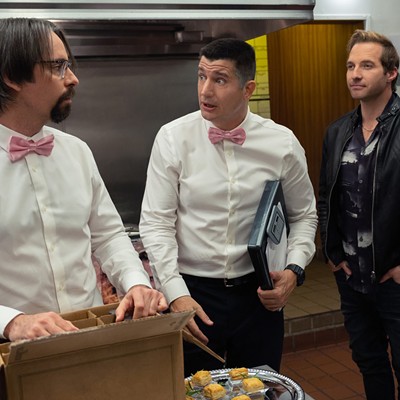Wednesday, May 4, 2011
The problem with 'Fringe'
Somewhere along the line, the TV show Fringe became a fringe TV show.
Fringe has an extremely small, extremely loyal audience. That’s why Fox renewed it for next season, and that’s why Fox will probably not renew it next year. Thus, Fringe is in a unique position: Its only audience is its die-hard fans.
This focus on preaching to the fans, leaving the casual viewer behind, has had a curious effect: The quality of the show, throughout its run, as been like a bell curve — soaring, and then plateauing, and then sliding unfortunately downward.
Fringe began as extremely formulaic. It was X-Files with cheerier lighting, House with bigger parasites. It was simple: Something horrific and strange happened before the credits, the team ran around to try to figure out why, then, with just a few minutes before the victim/the city/the universe is destroyed forever, here comes a wave of technobabble, a fine heart-wrenching moment of acting from John Noble, and, hooray, we’re saved until next week.
The only larger story involved hints at “The Pattern” and some vague menace to mysterious superscience corporation Massive Dynamic.
But then, with the first season finale, Fringe ended with a shocking image — our hero, Olivia Dunham, landing in an alternate universe where the Twin Towers still stood. The major
reveal that began driving the story: Turns out Peter Bishop was actually from
that alternate universe, that he had been kidnapped by his father (mad
scientist Walter Bishop) after his actual son (the Peter Bishop from our
universe) died of illness. It’s a complicated sci-fi premise, but the ensuing
guilt, agony and anger that Walter Bishop (from both universes) shows propels it to compelling viewing.
That theme gave us “White Tulip,” one of the strongest, most meaningful standalone sci-fi stories ever, by tying one man's guilt over losing his wife to Walter Bishop’s guilt over kidnapping his own son.
But here, it seems, the show peaked. Fringe fans praise the show,
saying it's taking risks. But it’s taking the same risks, with diminishing
returns, as it did for the past few seasons — and risks aimed at pleasing the fans.
Recently, it seems as if the writers stood in front a whiteboard and
brainstormed the show’s strengths: ---
1) Showing different variations of the central cast, in different forms or different worlds
2) Tying science-fiction stories to emotional themes, like love, guilt, or revenge
3) Striving to satisfy its diehard, intractable fans instead of the casual viewer.
The last season seems to have been using those strengths, in a very calculating way, to construct the rest of the show. Yet by doing so, Fringe has become a much weaker show in the latter half of this season. Almost self-indulgent.
Last season, Fringe brought its narrative momentum to a halt with a drug trip that resulted in a musical film noir-style quirkiness. Fancy costumes. This season, in an even bigger misstep, during a trip inside a main character’s mind resulted in much of the episode being animated. Like A Scanner Darkly animated. The animation was shoddy, the gimmick was a distraction from the emotional core, and the season suffered from it.
Fringe’s penultimate episode ended with a reveal that, somehow, Peter Bishop had been transported to the future. The future, of course, was grim and dystopic. It would be a great twist, of course, if it wasn’t for the fact that A) Dollhouse already did it, B) it’s a retread of Season One’s alternate universe twist, C) it essentially adds variations on characters, instead of deepening the ones we currently have.
By the time this season is done we will have seen at least eight versions of Walter Bishop: present-day Walter, alternate-universe present-day Walter, 1980s-flashback Walter, alternate-universe 1980s-flashback Walter, film noir drug-trip Walter, animated Walter, future Walter, and alternate-universe future Walter.
Secondly, Fringe has a habit of layering emotional stakes, a la “White Tulip,” onto nearly every story, big or small. Some, like an episode that riffs on Flowers for Algernon, are compelling. But most, like a story in which a woman’s inability to let her dead husband’s memory go is creating a rip in space-in-time, have felt too desperate.
The notion that, in the alternate universe, a mad scientist wants to destroy our universe, partly in revenge for his son being kidnapped, should be emotional stakes enough.
But instead, Fringe added another layer, implying that the only way for the universe to be saved is for Peter Bishop and Olivia Dunham to love each other. Peter and Olivia don’t have much chemistry. This seemed to be a way to layer on emotional stakes and satisfy “shippers” — fans that want two specific characters to hook up.
But as Dan Harmon, showrrunner of Community, has explained, one of the quickest ways to get casual viewers to hate a couple is to tell us they’re destined for each other, especially if they don’t have natural chemistry. Fringe did exactly that, implying that not only was it prophesied that Peter and Olivia be connected, their relationship was literally the key to the universe’s survival.
Part of Lost’s strength was the way the show morphed to a show about survival, to a show about mystery, to a show about conflict between two groups, to a sci-fi show about time travel, to a show about dueling demi-gods. Everyone has their favorite season, but the show never grew stale.
But by repeating variations of what has worked in the past, with different variations, Fringe forces its story into an awkward, predetermined mold and invites comparisons to better moments. Fringe has been renewed for what is probably its final season. With that, it has the gift and curse of freedom: Let’s hope the final season tells a unique, cohesive story, instead of just one that will satisfy fans.
My suggestion? In Friday’s season finale, kill off some beloved characters. Destroy our universe, and have the entire next season take place in
the alternate universe. Great shows aren't just afraid of the fans. Don’t just give variations on the status
quo – change it entirely.
Tags: Television , FOX , Science-Fiction , TV , Video





















